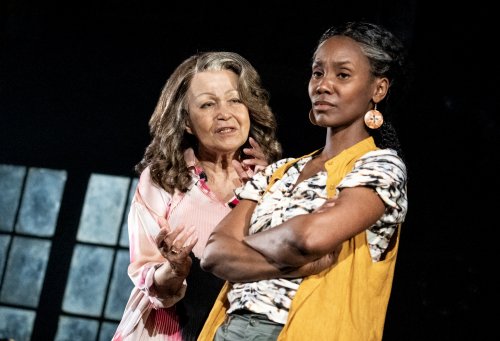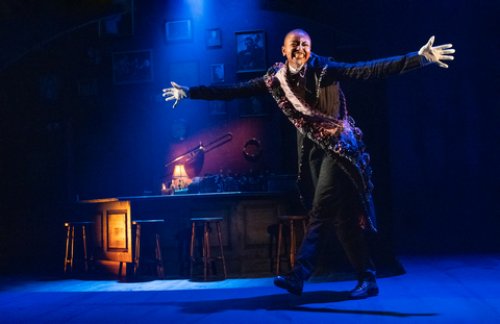shadow/land
A natural disaster is turned into a dark work of art set in New Orleans during Hurricane Katrina.

Lizan Mitchell and Joniece Abbott-Pratt in a scene from Erika Dickerson-Despenza’s “shadow/land” at The Public Theater (Photo credit: Joan Marcus)
[avatar user=”Joel Benjamin” size=”96″ align=”left”] Joel Benjamin, Critic[/avatar]
shadow/land by Erika Dickerson-Despenza is a play about the August 2005 disaster, Hurricane Katrina. It is the first episode of a ten-part magnum opus.
shadow/land, though, is more than a play. It is a painfully rich vision of what hundreds and hundreds of stranded rooftop denizens, so touted in the media, must have gone through behind the waterlogged walls of New Orleans. It is the rare theatrical work that recreates the agony and frustration of a natural disaster that transcends the fourth wall, seemingly without artifice, so involving is the entire endeavor.
Ruth (Joniece Abbott-Pratt) has reluctantly returned to Shadowland, a neighborhood bar/restaurant/hangout so that her contentious, commanding mom Magalee (Lizan Mitchell) could retrieve a pocketbook she left there. Even though the weather threat is already dire, Magalee needs her pills. She is in her eighties and is an owner of Shadowland which Ruth is trying to sell to a developer.

Lizan Mitchell and Joniece Abbott-Pratt in a scene from Erika Dickerson-Despenza’s “shadow/land” at The Public Theater (Photo credit: Joan Marcus)
The petty arguments and family reveals are in stark contrast to the vast storm raging around courtesy of Palmer Hefferan’s brilliant sound design of rain and thunder plus Jeanette Oi-Suk Yew’s moody lighting spiced with lightning and chiaroscuro.
Water is rising—quite literally—in Jason Ardizzone-West’s brilliantly evocative set—an old bar decorated with decades of photos, tchotchkes and the flotsam and jetsam of thousands of neighborhood residents, fronted by an ever-rising moat of storm water. Their neighborhood has changed and not for the better; old timers are disappearing and crime is becoming endemic. Even so, Ruth and Magalee fight over signing the paper transferring the building to the developer.
Two fine actors enact a very human tragedy told in the lovely local accent, the Louisiana patois, with quotidian references. The impact is universal as the depth of their tragedy engulfs them: no food; no potable water; no communication with the outer world except for a radio which soon fails. Helicopters overhead can’t see them until it is too late.

Christine Shepard in a scene from Erika Dickerson-Despenza’s “shadow/land” at The Public Theater (Photo credit: Joan Marcus)
A third actor, Christine Shepard, plays the Grand Marshal, a reference to the leader of the Mardi Gras. In face-covering makeup and a colorfully decorated costume (all costumes by Azalea Fairley), she begins Shadow/Land by entertaining the audience, slowly bringing attention to the two main characters. Inevitably, she takes on the persona of an angel of death, sardonically prancing about the suffering mother and daughter.
This is acting of the highest order, the kind of performances that make their own reality. So total is the involvement of the actors that their story and relationship gradually seeps into the subconscious of the audience.
The ending finds the audience in awed silence, a tribute to the actors.
Candis C. Jones has directed Dickerson-Despenza’s work with subtlety, allowing the actors their sway.
shadow/land is a totally involving work of art, despite its darkness.
shadow/land (through May 28, 2023)
LuEsther Hall, Public Theater, 425 Lafayette Street in Manhattan
For tickets, call 212-539-8500 or visit http://www.PublicTheater.org
Running time: 90 minute without an intermission






Leave a comment